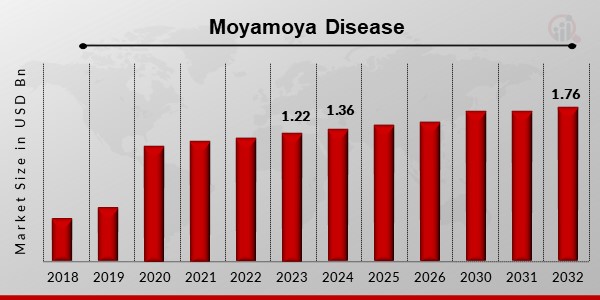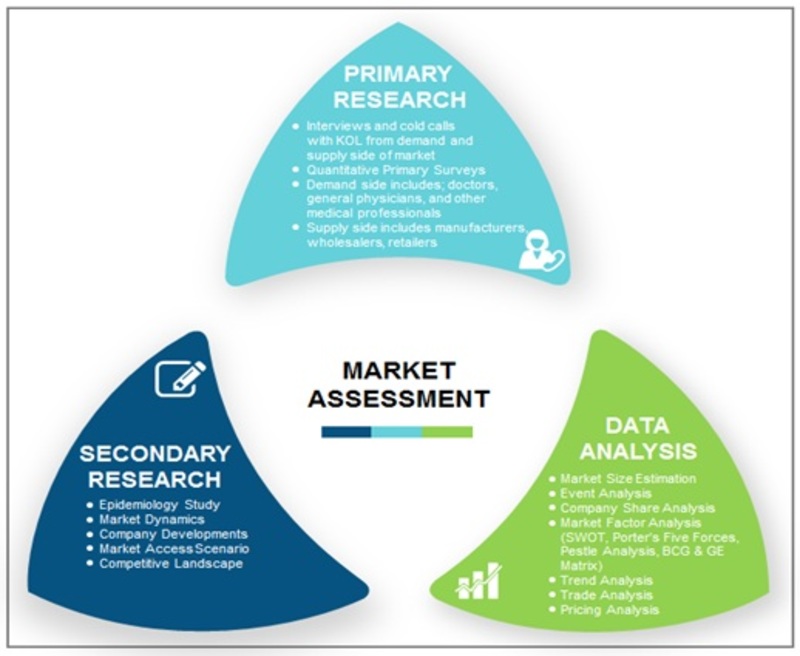Moyamoya Disease Market Overview
Moyamoya Disease Market Size was valued at USD 1.22 Billion in 2023. The Global Moyamoya Disease industry is projected to grow from USD 1.36 Billion in 2024 to USD 1.76 Billion by 2032, exhibiting a compound annual growth rate (CAGR) of 6.10%during the forecast period (2024 - 2032).

Moyamoya disease (MMD) is a chronic, cerebrovascular disease characterized by progressive stenosis in the internal carotid artery and an abnormal vascular network at the base of the brain. The stroke is one of the significant symptoms of moyamoya disease, which further leads to paralysis of the face, arms, and legs, loss of speech, and temporary loss of neurologic function of body parts, visual disturbances, headaches, developmental delay, and seizures.
According to the National Organization for Rare Diseases, in Japan, moyamoya disease is estimated to occur in 1 per 1 million people, and the condition is more prevalent in females under the age of 20. It is also reported that nearly 10% of cases of moyamoya disease in Asian countries have a genetic cause. Recently, two major mutations have been found to be associated with a specific population of moyamoya patients i.e. R179, and RNF213 mutations.
Intended Audience
- Pharmaceutical Companies
- Research and Development (R&D) Companies
- Diagnostic Laboratories
- Government Research Institute
- Academic Institutes and Universities
Moyamoya Disease Market Key Players
Some of key the players in the moyamoya disease market are:
- Abbott Laboratories
- Boston Scientific Corporation
- Cephalon, Inc.
- Cordis Corporation
- Eisai Co., Ltd
- GE Healthcare
- Genentech Inc.
- GlaxoSmithKline PLC.
- Johnson & Johnson
- Koninklijke Philips N.V.
- Medtronic plc
- Merck & Co. Inc.
- Novartis AG
- Pfizer, Inc.
- Sanofi
- Siemens
- Stryker
- Sunovion Pharmaceuticals, Inc.
- UCB Pharma Ltd.
- Valeant Pharmaceuticals International
Research Methodology 
Sources: Annual reports, Press release, White paper, and Company presentation
It is noted that growing public awareness and technological advancements are the key factors driving the moyamoya disease market. Nowadays, people are becoming more aware of different types of neurological disorders. Government and other different organizations have started educating people about hygiene and diseases through seminars, and conferences. People are becoming more aware and health conscious. Thus, increasing awareness has provided a push to the growth of the market. The new and existing marketers are also contributing to control this condition. For instance, on April 13, 2016, Silk Road Medical, Inc., received FDA approval for its next-generation ENROUTE Transcarotid Neuroprotection System (NPS). The NPS is specifically designed and indicated for transcarotid artery revascularization.
Various other factors such as increased incidence of neurological disorders, unmet medical needs, increasing government assistance, improving regulatory framework, increasing adoption rate, and rising funding and reimbursement are continuously contributing to the growth of the moyamoya disease market.
Despite these drivers, there are some issues associated with moyamoya disease market. The challenges in research and development, cost of treatment, side-effects of treatment, the presence of misbranded and spurious drugs, and poor healthcare system in low and middle-income countries, may hinder the growth of the market to an extent.
Moyamoya Disease Market Segmentation
The moyamoya disease market is segmented on the basis of diagnosis, treatment, and distribution channels.
On the basis of the diagnosis, the market is classified as a cerebral angiogram, magnetic resonance imaging (MRI), magnetic resonance angiogram (MRA), computed tomography (CT) scans, transcranial Doppler ultrasound, positron emission tomography (PET) scan, and electroencephalography (EEG).
On the basis of the treatment, the moyamoya disease market is classified as surgical treatment and non-surgical treatment. The surgical treatment is further classified as pial synangiosis, indirect procedures, and direct arterial bypass. The sub-segment of indirect procedures includes EDAS (encephaloduroarteriosynangiosis), EMS (encephalomyosynangiosis), Omental transposition/transfer, and dural inversion. The non-surgical treatment is further classified as anticoagulation and antiplatelet therapy, and others. The sub-segment of anticoagulation and antiplatelet therapy include heparin, warfarin, aspirin, and others.
On the basis of the distribution channel, the moyamoya disease market is segmented into hospitals, clinics, diagnostic centers, drug stores, pharmacies and others.
Moyamoya Disease Market Regional Analysis
The Americas dominate the moyamoya disease market owing to the rising awareness among people, and high healthcare expenditure. According to the Centers for Disease Control and Prevention in 2015, the total health expenditure in the United States was reported to be USD 3.2 trillion and hospital care accounted for a share of 32.3%.
Europe holds the second position in the moyamoya disease market. It is expected that the support provided by the government bodies for research & development and improvement in reimbursement policies in the healthcare is likely to drive European market.
The Asia Pacific is the fastest growing moyamoya disease market owing to a huge patient pool and developing healthcare technology. Healthcare expenditure is also improving in various Asia Pacific countries. According to the Australian Institute of Health and Welfare in the years 2015-2016, the total health expenditure was USD 170.4 billion, which is 3.6% higher than the expenditure of 2014-2015
The Middle East & Africa holds the lowest share of the global market due to lack of technical knowledge and poor medical facilities.
|
Report Attribute/Metric
|
Details
|
|
Market Size 2023
|
1.22 (USD Billion)
|
|
Market Size 2024
|
1.36 (USD Billion)
|
|
Market Size 2032
|
1.76 (USD Billion)
|
|
Compound Annual Growth Rate (CAGR)
|
6.1 % (2024 - 2032)
|
|
Report Coverage
|
Revenue Forecast, Competitive Landscape, Growth Factors, and Trends
|
|
Base Year
|
2023
|
|
Market Forecast Period
|
2024 - 2032
|
|
Historical Data
|
2019 - 2023
|
| Forecast Units |
Value (USD Billion) |
| Segments Covered |
Type, Application, and End-User |
| Geographies Covered |
North America, Europe, Asia-Pacific, and Rest of the World (RoW) |
| Key Vendors |
Abbott Laboratories, Boston Scientific Corporation, Cephalon, Inc., Cordis Corporation, Eisai Co., Ltd, GE Healthcare, Genentech Inc., GlaxoSmithKline PLC., Johnson & Johnson, Koninklijke Philips N.V., Medtronic plc, Merck & Co. Inc., Novartis AG, Pfizer, Inc., Sanofi, Siemens, Stryker, Sunovion Pharmaceuticals, Inc., UCB Pharma Ltd., Valeant Pharmaceuticals International |
| Key Market Opportunities |
Increasing government support, rising investments in healthcare, and the presence of a well-established pharmaceutical market |
| Key Market Drivers |
Growing public awareness, technological advancements, rising adoption of innovative treatment methods, increasing incidence of neurological disorders, and government support |
Frequently Asked Questions (FAQ) :
The moyamoya disease market is projected to grow at a 6.10% CAGR between 2024-2032.
The Americas is projected to lead the moyamoya disease market.
Increasing government assistance and rising prevalence of neurological disorders are the key factors driving the moyamoya disease market.
Side effects and high treatment cost may limit the moyamoya disease market growth.
Eminent players profiled in the moyamoya disease market include Valeant Pharmaceuticals International, Inc., UCB Pharma Ltd., Sunovion Pharmaceuticals, Inc., Stryker, Siemens, Sanofi, Pfizer, Inc., Novartis AG, Merck & Co. Inc., Medtronic plc, Koninklijke Philips N.V., Johnson & Johnson, GlaxoSmithKline PLC., Genentech Inc., GE Healthcare, Eisai Co., Ltd, Cordis Corporation, Cephalon, Inc., Boston Scientific Corporation, and Abbott Laboratories.

















